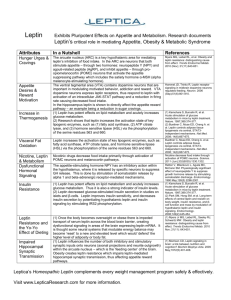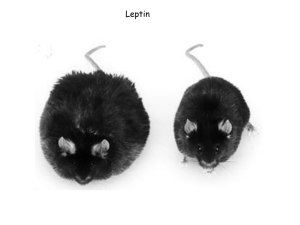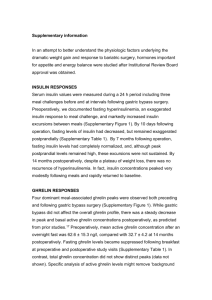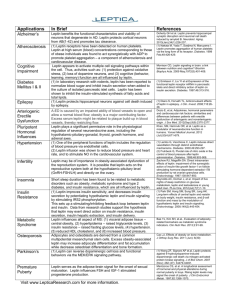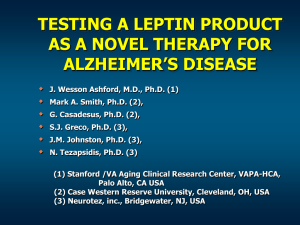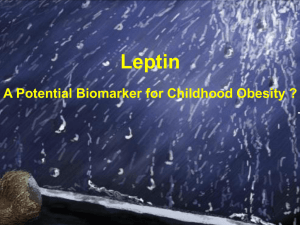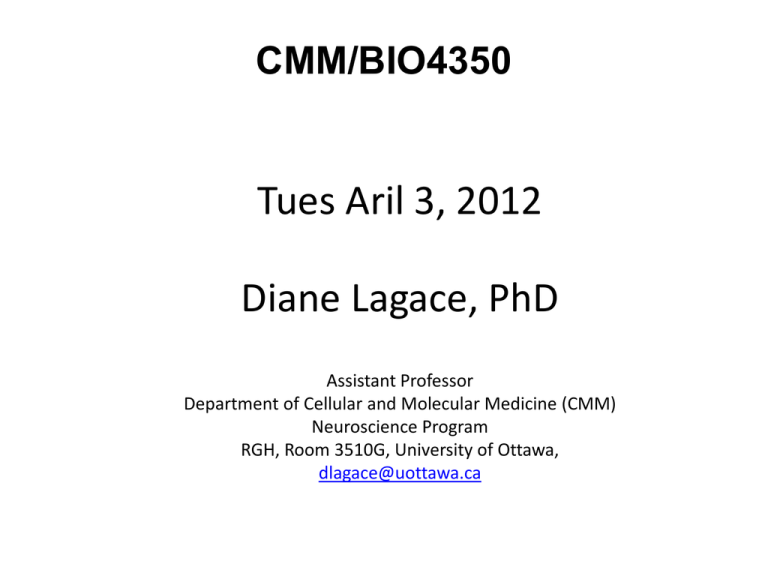
CMM/BIO4350
Tues Aril 3, 2012
Diane Lagace, PhD
Assistant Professor
Department of Cellular and Molecular Medicine (CMM)
Neuroscience Program
RGH, Room 3510G, University of Ottawa,
dlagace@uottawa.ca
Exam Info
INSTRUCTIONS
This is a closed-book exam. No supplemental materials are allowed.
Read each question carefully and answer ALL questions.
The exam will be graded out of a total of 50 marks.
The first section is based on Dr. Beique’s material and is worth 10 marks. This includes
questions B1-B3.
The second section is based on Dr. Maler’s material and is worth 10 marks. This
includes questions M1-M3.
The third section is based on Dr. Lagace’s material and is worth 30 marks. This includes
questions L1-L17.
6 Lectures
1.
2.
3.
4.
Embryonic Development 101
Chapter 7: Understanding CNS structure through development (p178-201)
Gross Neuroantaomy
Chapter 7: Gross Organization of Mammalian Nervous System (p168-176)
Chapter 23 Genesis of Neuron, Connections and Elimination of Cells and Synapses
(p690-707
Chapter 7 Appendix: Illustrated Guide to Human Neuroanatomy (p206-248)
The Genesis of the Neuron (Neurogenesis) and Neuronal Connections and Regeneration of Nervous System
Chapter 23: Connections and Elimination of Cells and Synapses (p690-707)
From lecture notes only; not in text book
Chemical Controls of Brain and Behavior
Chapter 15: Hypothalamus, ANS, Neurotransmitter Systems (p482-504)
5.
Motivation and Homeostasis
Chapter 16: Feeding Regulation Short and Long-Term and Why We Eat
(p510-527)
6.
Sex and the Brain
Chapter 17 (p534-561)
1.
Hypothalamus and Homeostasis
2.
Energy Balance – Long term regulation of Feeding
3.
Set Point for Body Weight
4.
Discovery of Leptin
5.
Hypothalamic Lesions and Feeding Behavior
6.
Response to Elevated or Reduced Levels of Leptin
7.
Anorectic and Orexigenic Peptides from Arcuate Nucleus
8.
Orexigenic Peptides from Lateral Hypothalamus (MCH and Orexin)
9.
Short-term regulation of feeding:
•
Ghrelin, Gastric Distension, CCK, Insulin
10. Insulin and Leptin
Patterns of Communication in Nervous System
Neuron-Neuron
Point-Point
3 MORE BROAD
Hypothalamus
ANS
Modulatory
Neurotransmitter
System
p483
Hypothalamus - Homeostatsis
Regulatory process: Regulates body
temperature and blood composition
• Hypothalamus commands in cold
weather
• Shiver, goosebumps, turn blue
• Hypothalamus commands in hot weather
• Turn red, sweat
p484
Homeostatsis – Negative Feeedback
http://www.mattk.com/anatomy_notes_homeostasis_negative_feedback.php
In negative feedback the body responds to an extreme condition by reversing the current
direction of change (thus the term negative feedback). The goal is to always keep the
internal conditions within a normal range.
Homeostatsis
Hypothalamic Regulation
Three components of how hypothamalus neurons respond to sensory signals
Humoral response:
Stimulating or inhibiting release of pituitary hormones into the blood
stream
Visceromotor response:
Adjust the balance of the sympathetic and parasympathetic outputs of the
ANS
Somatic motor response:
Appropriate somatic motor behavioral response
P510-511
Anabolism During Prandial State
(Latin for “Breakfast”)
p512
Catabolism during Postabsorptive State
p512
Catabolism during Postabsorptive State
p512
Stress Response - Short and Long-term Response
p490
See danger
During exams
Energy Balance and Eating
Long-term response: maintain body fat reserves
Short term response: regulate meal size and frequency
p512
Maintenance of Body Weight and Set Point
p513
Lipostatic Hypothesis: 1953: Brain monitors the amount of body fat
Coleman and Friedman and the
Discovery of Leptin
http://www.youtube.com/watch?v=tyusgTI3Syo
p514
From Mice to Men
Yet there are very few cases of this miracle cure ;(
Similar on
p514
http://media.hhmi.org/hl/04Lect1.html #21
Genetic Basis to Weight
Identical twins (Monozygote) have almost exactly the same genetic make-up.
Non-identical twins (Dizygote), on the other hand, share about 50% of the
genetic traits. It has been shown from twin studies that percentage of
heritability of obesity ranges between 70 % to 80% - the only trait being
higher than obesity is your height!
p514
Leptin is the afferent signal in a negative feedback loop that maintains homeostatic control of
adipose mass. It circulates in the blood and acts on the brain to regulate food intake.
When fat mass falls, plasma leptin concentrations fall too, stimulating appetite and
suppressing energy expenditure until fat mass is restored.
When fat mass increases, leptin levels increase, suppressing appetite until weight is lost. This
system maintains homeostatic control of adipose tissue mass.
Leptin thus conveys nutritional information to specific neural populations in the brain, which
in turn regulate most, and perhaps all, other physiological systems. This homeostatic system
enables mammalian organisms to maintain optimal levels of stored energy (fat) under a wide
range of environmental conditions.
MOVIE http://media.hhmi.org/hl/04Lect1.html #21
A tale of two hormones
Jeffrey M Friedman Nature Medicine 16, 1100–1106 (2010)
http://im-09-tb.blogspot.ca/2009/03/obesity-reviving-promise-of-leptin_3
Hypothalamus and Feeding
Back to 1940s and lesion studies and incorrect
dual center model hypothesis
Hunger center
Satiety center
p515
Three Hypothalamic Nuclei Important for Feeding
p516
Increase Leptin Levels – Body Fat is Increased
– Activation of aMSH and CART
containing arcuate neurons
–
aMSH: alpha melanocyte stimulating hormone,
–
CART = cocaine- and ampethamine-regulated
transcripts
CAREFUL HERE –
–
alpha-melanocyte stimulating hormone is a
post-translational derivative of
proopiomelanocortin, Pomc – THEREFORE
MANY INTRO BOOKS TALK OF POMC
P516-7
http://en.wikipedia.org/wiki/File:POMC.png
http://knol.google.com/k/the-genetics-of-obesity#
Increase Leptin Levels – Body Fat is Increased
– Activation of aMSH and CART
containing arcuate neurons
– INDUCES:
– Humoral response: increase
activity of paravenctricular
nucleus to increase secretion
of TSH and ACTH from
anterior pituitary
P516-7
Neurosecretory cells of the hypothalamus
Parvocellular neurosecretory cells
secrete hypophysiotropic
hormone into hypo-pituitary
portal circulation
Hormones act in anterior lobe of
pituitary where they trigger
release or inhibitions of pituitary
hormone release.
Last lecture
p489
Hormones Released by Anterior Pituitary Gland
Last lecture
p488
Increase Leptin Levels
– Activation of aMSH and CART
containing arcuate neurons
– INDUCES:
– Humoral response: increase
activity of paravenctricular
nucleus to increase secretion of
TSH and ACTH from anterior
pituitary
– Visceromotor response: increase
tone of sympathetic division of
ANS through axons that project
from either paravenctricular or
arcuate
P516-7
Increase Leptin Levels
– Activation of aMSH and CART
containing arcuate neurons
– INDUCES:
– Humoral response: increase
activity of paravenctricular
nucleus to increase secretion
of TSH and ACTH from
anterior pituuitary
– Visceromotor response:
increase tone of sympathetic
division of ANS
– Somatic motor response:
decrease feeding behavior
P516-7
What would happen if you
inject
aMSH or CART into the
brain?
P516-7
p519
Decrease Leptin Levels
– Stimulation of the NPY and AgRP
expressing arcuate neurons
– Humoral response: inhibit
secretion of TSH and ACTH
P516-7
p519
Competition for MC4 receptor
p518
Decrease Leptin Levels
– Stimulation of the NPY and AgRP
expressing arcuate neurons
– INDUCES:
– Humoral response: inhibit
secretion of TSH and ACTH
– Visceromotore response:
increase tone of
parasympathetic division of
ANS (not shown;()
– Somatic motor response:
stimulate feeding behavior
P516-7
2 more Orexigenic Peptides
That Control Feeding from Lateral Hypothalamus
p519
Orexin and MCH both rise when leptin levels are reduced
http://archives.focus.hms.harvard.edu/1999/Sept17_1999/research_briefs.html
Orexin
Orexin was discovered almost simultaneously by two independent groups
of rat-brain researchers.[4][5]
One group named it orexin, from orexis, meaning "appetite" in Greek;
the other group named it hypocretin, because it is produced in the
hypothalamus and bears a weak resemblance to secretin, a hormone found
in the gut.[2]
narcolepsy
http://www.yourdiscovery.com/video/is-it-possible-narcoleptic-dog/
http://en.wikipedia.org/wiki/Orexin
Orexin - Hypocretin
When it is time to be awake, there are certain
neurons in your brain that release hypocretin. This
hypocretin tells the brain to be awake.
When it is time to go to sleep, brain cells make less
hypocretin. Now you get sleepy and fall asleep.
It makes perfect sense that people with narcolepsy
have problems with their hypocretin. A sudden drop
in this key brain chemical and you'd go right to sleep.
In fact, doctors can now test to see if a person has
low levels of hypocretin by taking a sample of some
spinal fluid. This can help them figure out if a person
has narcolepsy. But they can't use hypocretin as a
curesince hypocretin will not pass blood brain barrier
and enter into brain
http://www.thetech.org/genetics/ask.php?id=419
More then just LEPTIN…..
CCK is present in some
cells in the intestines and
released as a satiety
peptide.
CCK
m-09-tb.blogspot.ca/2009/03/obesity-reviving-promise-of-leptin_30.html
Short-term regulation of Feeding Behavior
p520
http://7bigspoons.com/stress/stress-feel-hungry-nice/attachment/ghrelin/
Ghrelin was discovered in 1999
Hunger is not just the absence of satiety
Blood concentrations of ghrelin are lowest
shortly after consumption of a meal, then rise
during the fast just prior to the next meal
p520
p520
http://www.diabesity.eu/ghrelin.htm
Receptors for ghrelin have been found on NPY/AgRP neurons in the hypothalamic
arcuate nucleus.
The NPY neurons are potent stimulators of appetite and upon activation by ghrelin
they inhibit the POMC neurons by releasing the inhibitory neurotransmitter GABA
which inhibits the release of aMSH, an inhibitor of appetite.
Ghrelin also activates the release of AgRP which is an antagonist of the alpha MSH
receptors MC3 and MC4, blocking alpha MSH from activating its receptor and
p520
inhibiting appetite.
http://www.diabesity.eu/ghrelin.htm
Synergistic Action of Gastric Distension and CCK on Feeding
Both gastric distension and CCK
signals converge on axons in
vagus nerve
Result in reduce meal
frequency and size
CCK release in response to certain
type of food (especially fatty
ones)
http://goanimate.com/videos/0oL8bpkMa_HY
p520,521
Last one is insulin
CCK is present in some
cells in the intestines and
released as a satiety
peptide.
CCK
m-09-tb.blogspot.ca/2009/03/obesity-reviving-promise-of-leptin_30.html
Insulin
Celphalic Phase
Anticipating the food
Parasympathetic innervations
stimulates Bcells to release insulin
Small reduction in glucose in blood
Activation of NPY neurons in
arcuate
P522
Insulin
Gastric Phase
Food enters the stomach
Bcells to release insulin even more,
increase by release of CCK
Small reduction in glucose in blood
P522
Insulin
Substrate Phase
Food absorbed into intestines
Max amount of insulin release
Primary stimulus for insulin release
increase in blood glucose
P522
Insulin and Leptin
P522
http://www.medbio.info/Horn/Time%205/Metabolic%20syndrom%20and%20diabetes%20type%202.htm
Insulin and Leptin
P530
1.
Hypothalamus and Homeostasis
2.
Energy Balance – Long term regulation of Feeding
3.
Set Point for Body Weight
4.
Discovery of Leptin
5.
Hypothalamic Lesions and Feeding Behavior
6.
Response to Elevated or Reduced Levels of Leptin
7.
Anorectic and Orexigenic Peptides from Arcuate Nucleus
8.
Orexigenic Peptides from Lateral Hypothalamus (MCH and Orexin)
9.
Short-term regulation of feeding:
•
•
Ghrelin, Gastric Distension, CCK, Insulin
Insulin and Leptin
Example Question
During the winter months you have been eating a lot more food.
Using the following words (anterior pituitary, arcuate neurons, leptin, ACTH,
TSH, sympathetic activity, CART, somatic motor) describe regulation of feeding in
2-6 sentences.
You can use a diagram as part of your answer. 4 MARKS
Example Question
During the winter months you have been eating a lot more food.
Using the following words (anterior pituitary, arcuate neurons, leptin, ACTH,
TSH, sympathetic activity, CART, somatic motor) describe regulation of feeding in
2-6 sentences.
You can use a diagram as part of your answer. 4 MARKS
When you have been eating more for sustained periods of time you will have
more fat and this will increase the amount of leptin released from the fat storage.
Leptin will activate the CART and aMSH neurons in the arcuate neurons.
This will induce a humoral response which involves increased secretion of TSH and
ACTH from anterior pituitary.
There is also increase in tone of the sympathetic activity which rises metabolic
rate.
Lastly, there is somatic motor response that decreases feeding behavior.



